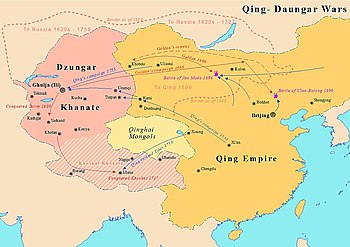
This is a timeline of the Xinjiang under the rule of the Qing dynasty.

This is a timeline of the Xinjiang under the rule of the Qing dynasty.
| Year | Date | Event |
|---|---|---|
| 1697 | ʿAbdu l-Lāh Tarkhān Beg rebels against the Dzungar Khanate in Hami [1] | |
| 1698 | Qing dynasty occupies Hami [2] |
| Year | Date | Event |
|---|---|---|
| 1720 | Amin Khoja leads a rebellion in Turpan against the Dzungar Khanate and defects to the Qing dynasty [2] |
| Year | Date | Event |
|---|---|---|
| 1732 | Dzungar Khanate attacks Amin Khoja, who takes his people to settle in Guazhou [2] | |
| 1737 | Abuse by the Dzungars cause residents of the Tarim Basin to flee to the Qing dynasty [1] |
| Year | Date | Event |
|---|---|---|
| 1755 | Dzungar–Qing Wars : ʿAbdu l-Lāh Tarkhān Beg, Amin Khoja, Yusuf Beg, and Hakim Beg Hojis join the Qing dynasty in invading the Dzungar Khanate and fighting Amursana's rebellion [2] | |
| 1757 | Revolt of the Altishahr Khojas : Khoja Burhan-ud-din and his brother Hojan rebel against the Qing dynasty in Yarkand [3] | |
| 1759 | Revolt of the Altishahr Khojas : 100,000 Qing troops enter Xinjiang, forcing the Khoja brothers to flee to Badakhshan, where the sultan has them put to death and presented to the Qing; the entirety of the Tarim Basin is conquered by the Qing dynasty [4] |
| Year | Date | Event |
|---|---|---|
| 1762 | An imperial governor-general is set up in Xinjiang, known as the Ili governor-general; Xinjiang is divided into three geographic units: the Ili and Tarbagatay regions, the eight cities south of the Tian Shan range, and Urumqi [4] |
| Year | Date | Event |
|---|---|---|
| 1777 | Population of the Tarim Basin reaches 320,000 [5] |
| Year | Date | Event |
|---|---|---|
| 1814 | Hereditary posts in Xinjiang are abolished [6] |
| Year | Date | Event |
|---|---|---|
| 1826 | Population of the Tarim Basin reaches 650,000 [5] |

The Protectorate General to Pacify the North or Grand Protectorate General to Pacify the North (647–784) was a Chinese military government established by the Tang dynasty in 647 to pacify the former territory of Xueyantuo, which extended from Lake Baikal to the north, the Gobi Desert to the south, the Khingan Mountains to the east, and the Altay Mountains to the west. It controlled the Mongolian Plateau from 647 to 682.

The Four Garrisons of Anxi were Chinese military garrisons installed by the Tang dynasty in the Tarim Basin between 648 and 658. They were stationed at the Indo-European city-states of Qiuci (Kucha), Yutian (Hotan), Shule (Kashgar) and Yanqi (Karashahr) in modern Xinjiang. The Protectorate General to Pacify the West was headquartered in Qiuci.

This is a timeline of the Tang dynasty. Information on areas and events relevant to the Tang dynasty such as the Wu Zhou interregnum, when Wu Zetian established her own dynasty, and other realms such as the Sui dynasty, Tibetan Empire, Nanzhao, the Three Kingdoms of Korea, Japan, and steppe nomads are also included where necessary.
The siege of Lüshun was a military conflict between the Later Jin and Ming dynasty. In the summer of 1634 the Jin attacked and conquered the port city of Lüshun from Ming.
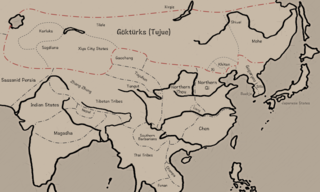
This is a timeline of the Göktürks from the origins of the Turkic Khaganate to the end of the Second Turkic Khaganate.
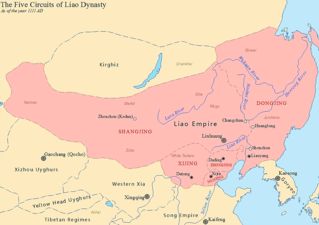
This is a timeline of the history of the Khitans. The Khitans were a nomadic people in Northeast Asia related to the Xianbei. Following the collapse of the Tang dynasty, they established the Liao dynasty in 916, encompassing parts of modern-day China, Mongolia, North Korea, and Russia. The Liao dynasty was eventually conquered by the Jin dynasty in 1125. Remnants of the Liao court led by Yelü Dashi fled westward to Central Asia where they established the Western Liao dynasty. In 1211, the Western Liao throne was usurped by a Naiman called Kuchlug. In 1218, the Mongol Empire defeated and conquered the Western Liao dynasty.
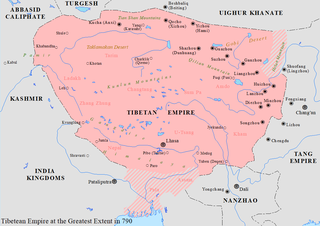
This is a timeline of the Tibetan Empire from 6th to 9th century.

This is a timeline of the Karluks. The Kara-Khanid Khanate is also included; however, it is disputed whether the Karluks or Yagmas were the dominant group within the khanate.

This is a timeline of the Jurchens.
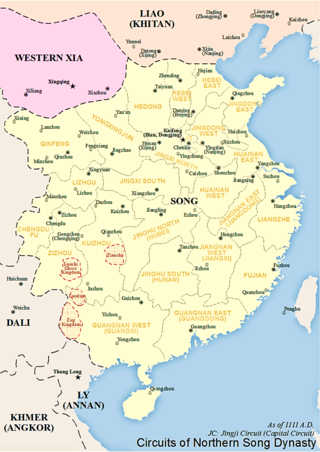
This is a timeline of the Song dynasty (960–1279). The Song dynasty was founded by Zhao Kuangyin, posthumously known as Emperor Taizu of Song, who ended the period of division known as the Five Dynasties and Ten Kingdoms period. The Song dynasty is commonly separated into two historical periods, the Northern Song (960–1127) and the Southern Song (1127–1279), divided by the loss of the north to the Jurchen Jin dynasty (1115–1234). In 1279, the Mongol Yuan dynasty conquered the Song.

This is a timeline of the Five Dynasties and Ten Kingdoms (907–979), which followed the collapse of the Tang dynasty in 907 AD. The Five Dynasties refer to the succession of dynasties which ruled northern China following the Tang collapse while the Ten Kingdoms, with the exception of Northern Han, ruled in southern China. This era of division ended in 979 AD with the rise of the Song dynasty under Emperor Taizu of Song, although the Song would never reconquer the northern territory lost to the Khitans, collectively known as the Sixteen Prefectures.
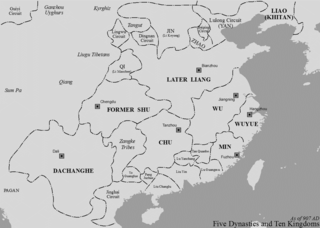
This is a timeline of the Tangut people and the Western Xia dynasty.

This is a timeline of Mongols prior to the Mongol Empire.
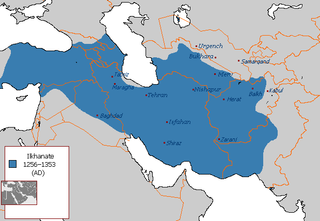
This is a timeline of the Ilkhanate.

This is a timeline of the Chagatai Khanate (1226–1348) and its successor states, Moghulistan (1347–1462), Yarkent Khanate (1514–1696), and the Turpan Khanate (1462–1680).
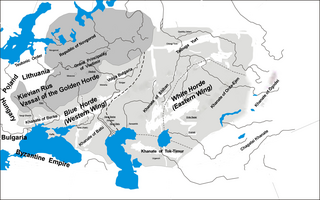
This is a timeline of events involving the Golden Horde (1242–1502), from 1459 also known as the Great Horde.

Yunnan under Ming rule refers to the rule of the Ming dynasty in Yunnan, which saw the continuation of the tusi system instituted during the Yuan dynasty, increasing centralization, and Han migration into Yunnan.

This is a timeline of the Qing dynasty (1644–1912).

The Jurchen unification were a series of events in the late 16th and early 17th centuries that led to the unification of the Jurchen tribes under the Jianzhou Jurchen leader Nurhaci. While Nurhaci was originally a vassal of the Ming dynasty who considered himself a local representative of imperial Ming power, he also had a somewhat antagonistic relationship with the Ming due to Ming's involvement in events early on in his life that led to the death of his father and grandfather combined with his own increasing ambition.

This is a timeline of the Era of Fragmentation, the period of Tibetan history lasting from the death of the Tibetan Empire's last emperor, Langdarma, in 842 until Drogön Chögyal Phagpa gained control over the three provinces of Tibet in 1253 under Mongol rule.